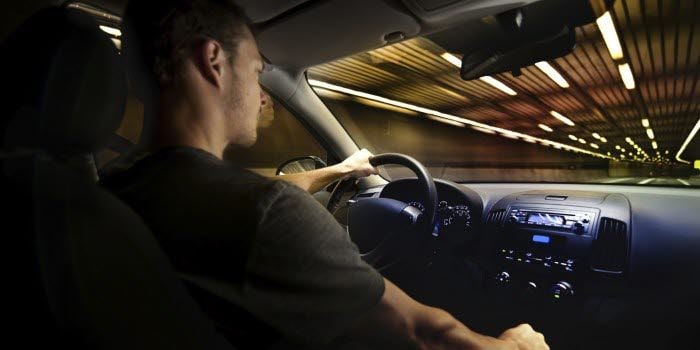Last autumn, in a laboratory at the University of Turku in Finland, thirty-four young people allowed their brains to be scanned while playing car race video games.
The aim was to win. But the speeds were fixed and subjects only had the use of a start and stop button. They had to decide how to drive through twenty traffic-light junctions on being met with a yellow light each time. A scanner recorded the activity in their young brains throughout.
Would they stop, or take a chance?
Brain research funded by the public roads authorities
The Neurodriving Project, launched in 2012, is a collaborative effort between the Norwegian Public Roads Administration (NPRA), SINTEF, the University of Turku and the Finnish Directorate of Public Roads (TraFi).
Senior Researcher Dagfinn Moe at SINTEF has been studying young motorists for many years, trying to find explanations for young people's risk behaviour – a field that encompasses many scientific disciplines including psychology, neurobiology and sociocultural factors.
In Finland, Research Director Sami Myntinnen at TraFi was interested in studying the brains of young people in the light of recent knowledge. Just like his Norwegian colleague he was wondering what it would mean to understand and influence these risk-takers' behaviour. Moe contacted the NPRA, which was more than willing to take part in such a project.
The aim was to study how young motorists dealt with a particular driving problem, the approach they selected, and the nature of their brain activity as they made their decisions.
In Finland, Research Director Sami Myntinnen at TraFi was interested in studying the brains of young people in the light of recent knowledge. Just like his Norwegian colleague he was wondering what it would mean to understand and influence these risk-takers' behaviour. Moe contacted the NPRA, which was more than willing to take part in such a project.
The aim was to study how young motorists dealt with a particular driving problem, the approach they selected, and the nature of their brain activity as they made their decisions.
High-risk boys
For many years, the hard facts have told us that young people are over-represented in traffic accidents, and that young men in the age range 18 to 24 are at the highest risk.
When the researchers came to selecting their test subjects, it was important to include young people who exhibited different levels of risk-taking behaviour. After a series of psychological tests and behavioural investigations, they selected 17 risk-willing and 17 risk-averse young people.
"It took about 5 minutes to drive along the section of road in the video game", says Moe. "At each junction, the driver has to make a choice. If he runs a yellow light causing a collision, he has to wait six seconds before driving on. It takes three seconds to stop and wait for green, so by far the fastest way of completing the course is to run yellow lights without colliding", he says.
Brain activation
Moe says that the mechanism that controls the basis of our decision-making lies in the part of the brain called the frontal lobe. Before we make a decision, we gather information from our surroundings.
The study in which the young people took part involved traffic-light junctions where drivers were met by a yellow light.
"In the centre of our brains we have what is called the 'limbic' system – the brain's emotional centre. Two-way communication is carried out between this and the frontal lobe", says Moe. "All our lives we have to make balanced decisions, and emotions of all kinds are always linked to this process. In many cases our emotions will take the upper hand, causing us to take risks and act rashly and foolishly", he says.
High limbic activity
Moe shows us a series of images from brain scans of the young people showing cross-sections of the right and left hemispheres. He points to a couple of images where two yellow squares stand out in the centre of the brain. These are images taken from men in the high-risk group.
"It appears that all subjects obtain a neural response as they approach the traffic lights and encounter a yellow light", says Moe. "You can almost see what they are thinking", he says. "Aha! – what do I do now?", says Moe.
"Risk-averse drivers consider and balance their assessments to a much greater degree before they decide whether to stop or drive on", he says. "The high-risk group is dominated by motivation and emotions encouraging them to take a chance and drive on regardless. This group experience no dilemma, since they possess a 'drive' to obtain a reward and expect that things will turn out alright even if they run a yellow light", he says. "Reward experience and dopamine secretion are strong among these subjects, which means that high-risk takers choose to run a yellow light more often than risk-averse subjects", says Moe.
The emotional driving force and reward systems are thus stronger in adolescence than in later life, and control of the braking mechanisms by the frontal lobe is much less developed among the young.
Another interesting finding made by the researchers was linked to analyses of the anatomical neural connections between different areas of the brain. This area is called 'white matter' and consists of bundles of axons which help to promote rapid and stable communication.
"We have long believed that the neural network in the brains of young people has not completed its development, and that this is the reason behind a lack of holistic thinking combined with a willingness to take risks", says Moe. "However, we found that this network was actually better developed and more mature among high-risk takers than the risk averse", he says.
He concedes that this may seem paradoxical, but points out that risk-willingness is often linked to high levels of activity during which we challenge both our physical and mental capabilities.
"This in turn stimulates learning and coping behaviours and an increase in the numbers of neural connections in the brain. However, it doesn't totally prevent the motivation to make risky decisions and act on them", says Moe.
Next step
The researchers now want to examine educational approaches towards influencing the behaviour of high-risk takers. They believe that such approaches will not alter these subjects’ inherent nature, but will help them acquire a better balance between reward drive and the consequences of their actions.
"It's all about developing an ability to self regulate by getting young people to understand what taking risks really means", says Moe. "We also have ambitions to continue working together with our colleagues in Finland, where an international team has now been assembled and is studying this subject", he says.
Facts:
Scandinavian research has shown that the emotional centre in the brains of young motorists develops and matures ahead of the frontal lobe, and that this varies between risk-willing and risk-averse groups. The research has been headed by SINTEF and carried out at the Centre for Cognitive Neuroscience (CCN) at the University of Turku in Finland.
The project is funded by the Public Roads Directorate within the NPRA and its equivalent organisation in Finland, TraFi. This is the first time that the NPRA has funded a project of this type.
The Neurodriving Project involves the scanning of young people's brains while they play video games. Such games have previously been used in a study carried out at Temple University in Philadelphia, Pennsylvania.
In Turku an international team has been assembled with participants from Norway, Finland, South Korea and Russia to carry out these studies.
As part of the project RPM (Rounds Per Minute), currently being carried out in Sør-Trøndelag county under the auspices of the NPRA and the road safety organisation Trygg trafikk, the target group has been defined as young, risk-willing, motorists. Data from the Neurodriving Project is being applied in the approaches adopted in the RPM project.
SINTEF, in collaboration with Nord-Trøndelag University College (HiNT), has developed a programme now running at the Bratten activity centre in Bodø and. It is based on knowledge from this and similar projects and designed to influence young people's understanding of risk.
A so-called 'MIND' centre has been established and includes a programme based on audio, images and reflection in which young people participate.


